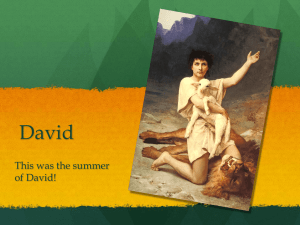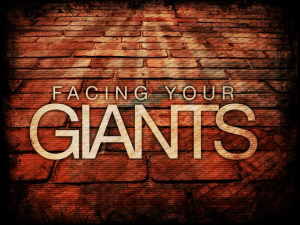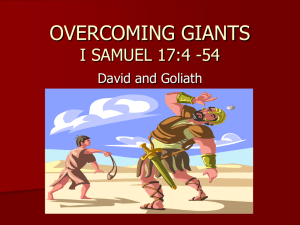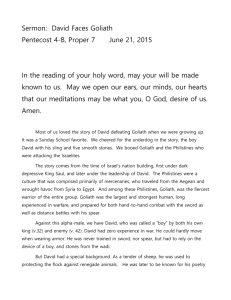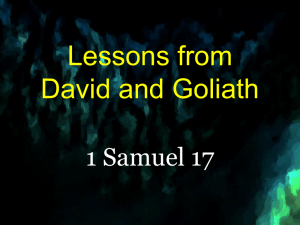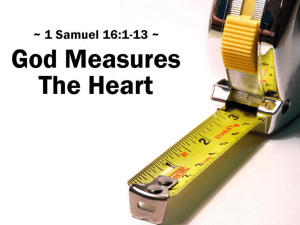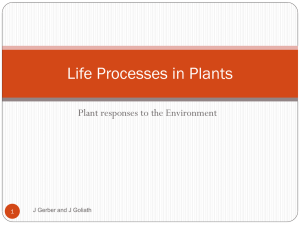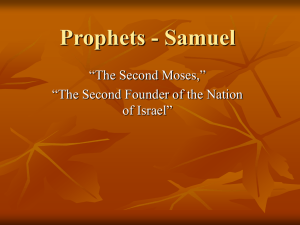David and Goliath: Overcoming Challenges with Faith
advertisement
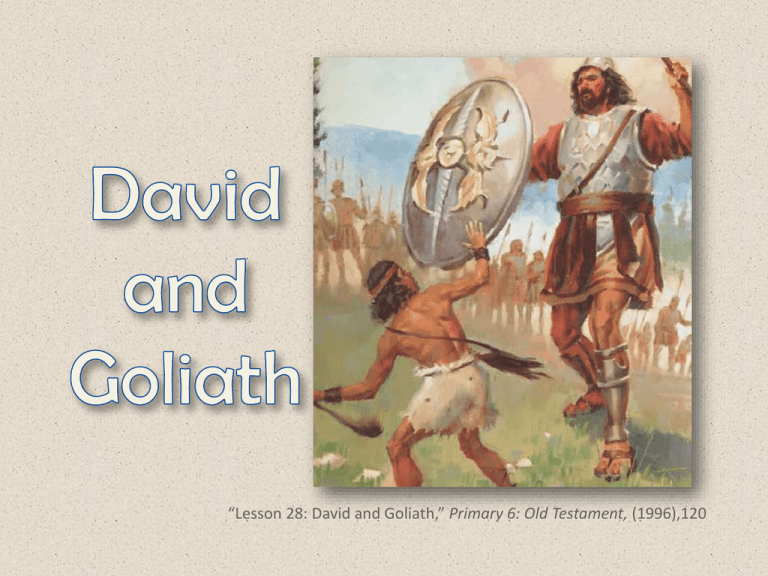
“Lesson 28: David and Goliath,” Primary 6: Old Testament, (1996),120 • Have you ever used stepping-stones to cross a stream or puddle? • I need a volunteer to demonstrate how this is done using the three flat “rocks” that are on the floor. • Stones can help us, but they can also cause us to stumble and fall if we aren’t careful. • I need a volunteer to read the label by the first stone. • How could this challenge be a stumbling block? • How could this challenge become a stepping-stone to make us better people? • Now, let’s read and discuss the labels by the other two stones. • The challenges in our lives can be stumbling blocks or stepping-stones depending on how we handle them. • If we become unhappy and angry because of the difficulties we face in life, they are stumbling blocks to us. • If we handle our difficulties with a positive attitude and learn from them, then we become better people and our challenges are like stepping-stones to us. • Our lesson today is about a boy named David who turned a difficult challenge into a steppingstone. • God told Samuel to go to Bethlehem. A man named Jesse lived there. One of Jesse’s sons would be the next king of Israel. • Samuel went to Bethlehem and asked Jesse to bring his sons to him. • Jesse and his sons came to Samuel. God had not chosen any of them to be king. Samuel asked if Jesse had any more sons. • Jesse said his youngest son, David, was not there. Samuel told Jesse to send for David. • David was taking care of the sheep. • David came to Samuel. David was a good boy. God said he had chosen David to be king. • Samuel anointed David and blessed him. • David was filled with the Holy Ghost. • David was anointed to become the next king. Someday he would be the king of Israel. • King Saul and the Israelites were at war with the Philistines. David was King Saul’s armor bearer. • One of the Philistines was a giant named Goliath. He was very big and strong. The Israelites were afraid of him. • Goliath shouted to the Israelites every morning and every night for forty days. • He told them to choose a man to fight him. None of the Israelites would fight him. • David’s brothers were in the Israelite army. Jesse sent David to take some food to them. • David saw the giant. He heard Goliath shouting. He saw that the men were afraid of Goliath. • What could the Israelites gain or lose in the fight with Goliath? • Let’s read 1 Samuel 17:8–9 • They were fighting to preserve their freedom. • Why didn’t any of the Israelites want to fight Goliath? • Let’s read 1 Samuel 17:4–7 • Goliath was approximately 9 feet 9 inches tall (3 meters), and it is estimated that his armor weighed 150 pounds (67.5 kilos). • I’ve cut this yarn to 9 feet 9 inches (3 meters) long. • Let’s attach this to the wall or ceiling so we can see how tall Goliath was. • Wow!!! That’s tall! Enrichment Activity #1 • Goliath’s armor weighed approximately 150 pounds (67.5 kilos). • That would be about the same about as two or three of you would weigh together. • How would you feel if you had to fight such an opponent? Enrichment Activity #1 • David said he would fight the giant. His brothers were angry and said he should be taking care of the sheep. • King Saul heard what David said and David persuaded him to be allowed to fight Goliath. • David had killed a lion and a bear with his slingshot to protect his father’s sheep. • Why was David at the battlefield? • Let’s read 1 Samuel 17:17–18 • Why was David’s oldest brother angry with him when he heard David asking about Goliath? • Let’s read 1 Samuel 17:26–28 • How did David’s brother misjudge him? • How can we avoid misjudging our brothers or sisters? • How can we overcome jealousy of others’ strengths or abilities? • What does David’s question, “Is there not a cause?” tell us about him? • Let’s read 1 Samuel 17:29 • A cause is a situation that can be resolved or made better by people getting involved in a positive way. • What was the cause David was referring to? • What righteous causes do young members of the Church have today? –Sharing the gospel –Obeying the Word of Wisdom –Keeping a clean mind –Being a good example –Giving service to those in need • What did David tell King Saul to convince him that he could kill Goliath? • Let’s read 1 Samuel 17:34–37 • Whom did David give credit to for delivering him from the bear and lion? • Let’s read 1 Samuel 17:37 • Whom should we give credit to when we succeed in overcoming a stumbling block? • King Saul wanted David to wear armor and carry a sword, but David didn’t want to wear it. • He said he could not because he had never used them before. • David knew God would help him. He picked up five stones. He took his sling and went to fight Goliath. • Goliath saw that David was very young and became angry. • He shouted at David and made fun of him. • David shouted back. He said God would help him kill Goliath. • How did Goliath prepare for the battle? • Let’s read 1 Samuel 17:5–7 • What weapons did David use? • Let’s read 1 Samuel 17:38–40 • What did David have that Goliath did not? • Let’s read 1 Samuel 17:45–47 • David’s real weapon against Goliath was help from the Lord. • Let’s act out the parts of David and Goliath by reading 1 Samuel 17:44 and 1 Samuel 17:45. Enrichment Activity #3 • David’s courage came from his faith in the Lord. • We all have obstacles, or “Goliaths,” in our lives. They can block our way to peace and happiness, as Goliath tried to block the way for peace and freedom of the Israelites. Enrichment Activity #3 • The following story is about President David O. McKay, ninth President of the Church, when he was young and faced an obstacle. • “One night [when I was young] … I awoke and soon imagined I could hear footsteps near the window. … My fears must have been at a pretty high pitch, for I breathed heavily, and it seemed I could hear my heart thumping. …” Enrichment Activity #3 • “True to my mother’s training and the natural yearning of my soul, I sought the Lord in prayer. To me there was only one way to pray and that was to kneel at the bedside. • “It was no small effort to get out of bed and kneel in the dark, but I did it, and prayed as never before for God’s comfort and protection. Enrichment Activity #3 • “Just as I said ‘Amen,’ I heard a voice say as distinctly as I ever heard a voice in my life, ‘Don’t be afraid, nothing will hurt you.’ • “Immediately all fear left me. I felt comforted at once and crept back to bed to a sweet and peaceful sleep” (“A Lesson in Faith,” Improvement Era, Aug. 1964, p. 637). Enrichment Activity #3 • Whom should we depend on when we face challenges? • What do we have to do to be worthy of that help? • The Lord helps us if our desires, like David’s, are righteous and if it is the Lord’s will that what we want to do should be done. • Goliath came at David to fight. • Then David put a stone in his sling and threw the stone. • The stone hit Goliath in the head and he fell to the ground dead. • How did Goliath react when he saw David coming to fight him? • Let’s read 1 Samuel 17:42–44 • How did David kill Goliath in spite of all the armor that Goliath was wearing? • Let’s read 1 Samuel 17:45–50 • While Goliath tried to protect himself physically, David protected himself spiritually. • Most of Goliath’s body was covered with armor, but since his forehead was unprotected, his physical armor was not enough to save him. • What can happen to us if our spiritual armor leaves us unprotected in some area? • How can we better protect ourselves spiritually? • David took Goliath’s sword and cut off his head. • The Philistines were afraid and ran away. God had helped David kill the giant. • Please put your chairs in a circle while I stand in the middle. • I want you to pass this stone around the circle while I hum a song. • When I stop humming please stop passing the stone. Enrichment Activity #2 • I am Goliath and will tell you a challenge. • The person who ended up with the stone must respond with a positive solution to the challenge. a. You have a younger brother or sister who seems to get all the attention. It makes you so angry that you feel like hitting him or her. Enrichment Activity #2 • I am Goliath and will tell you a challenge. • The person who ended up with the stone must respond with a positive solution to the challenge. b. Your best friends are starting to swear and they make fun of you because you do not swear. You want to be accepted by them, but you know it is wrong to swear. Enrichment Activity #2 • I am Goliath and will tell you a challenge. • The person who ended up with the stone must respond with a positive solution to the challenge. c. You have a very difficult time doing well in school. Enrichment Activity #2 • Choose “Goliaths,” or challenges, in your life you would like to overcome and write them on the giant. • Now, think of ways to overcome your challenges and write them on the paper stones. Enrichment Activity #4 • Not all challenges can be overcome, but if we ask Heavenly Father for his help, he will give us strength to cope with them. • Choose a challenge that you can work on and include faith and prayer as part of the solution. Enrichment Activity #4 • 1. Dare to do right! Dare to be true! You have a work that no other can do; Do it so bravely, so kindly, so well, Angels will hasten the story to tell. • Chorus Dare, dare, dare to do right; Dare, dare, dare to be true, Dare to be true, dare to be true. • 2. Dare to do right! Dare to be true! Other men’s failures can never save you. Stand by your conscience, your honor, your faith; Stand like a hero and battle till death. Enrichment Activity #5 • Words: George L. Taylor, b. 1835 Music: Arr. by A. C. Smyth, 1840–1909 • I appreciate Heavenly Father for the help I have received in overcoming my personal “Goliaths”. • I testify that if we will pray, have faith, and do our part, Heavenly Father will help us. • Images and clipart are from lds.org, sugardoodle.net, Microsoft Office, and other websites indicating the images were in the public domain. The hymns, lesson and scripture story are from www.lds.org. • Please do not use this presentation for commercial use. Feel free to alter the presentation for use in church or home to suit personal preference. • The presentation is intended to supplement, not replace, the lesson manual or scriptures. Teachers should refer to the manual and other resources when preparing and conducting the lesson.
